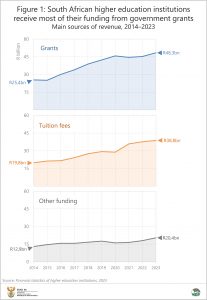University funding: Looking back at #FeesMustFall and COVID-19
South African universities faced a turbulent journey during the #FeesMustFall movement in 2015 and the COVID-19 pandemic in 2020. Both events had a significant impact on higher education funding. Stats SA explores how revenue streams for universities have shifted in the last decade, and how they were shaped by these two events.
The #FeesMustFall movement began in late 2015. The student-led protest was in response to rising tuition fees that made it increasingly difficult for poorer students to access higher education. The call for free higher education rapidly spread across the country, leading to intense protests and university shutdowns. The government responded with a zero-percent fee increase in 2016 and additional funding for economically disadvantaged students.
In 2020, COVID-19 lockdowns severely limited the operations of higher education institutions, resulting in the closure of many campuses and widespread disruptions to academic programmes.
Figure 1 depicts the three main revenue streams for higher education institutions, sourced from audited financial statements of South Africa’s public universities and universities of technology.1 Government grants – not to be confused with social grants – are financial transfers from government. These transfers represent the largest source of funding for higher education institutions, followed by tuition fees (which includes accommodation fees) and a miscellaneous category referred to as ‘other funding’ (which includes donations and research income).
Revenue from tuition fees remained almost flat in 2016 compared with 2015, reflecting government’s zero-percent increase in response to the #FeesMustFall movement. Grants, however, rose sharply in 2016 as government strove to fill the funding gap.
In 2020, during the height of the COVID-19 pandemic, revenue from tuition fees decreased by 1,6%. At the same time, government grants increased by 8,2%. Several factors contributed to the decline in tuition fees, including students cancelling accommodation placements in response to the hard lockdown, universities paying rebates to students on accommodation, and lower demand for short courses.
The COVID-19 pandemic also largely derailed research. Higher education institutions were forced to postpone or cancel research projects and conferences during the lockdown. This placed strain on research funding, contributing to a decline in the ‘other funding’ category.
As tuition fees and research funding softened in 2020, government grants increased, providing a much-needed buffer for struggling universities.
Funding from tuition fees rose sharply in 2021 as higher education institutions began to slowly reopen their doors. In 2023, tuition fees accounted for R38,8 billion (or 36%) of total higher education funding. Government grants accounted for the largest share (R48,3 billion or 45%). Other funding contributed R20,4 billion (or 19%).
As we look back over the last decade, the #FeesMustFall movement and the COVID-19 pandemic had an impact on university funding in South Africa. While government and higher education institutions continue to search for long-term financial solutions, innovative thinking in this space will help achieve a balance between financial sustainability and greater inclusivity.
1 Data in this article are sourced from the 2023 Financial statistics of higher education institutions statistical release. Download the release and associated Excel files here.
Similar articles are available on the Stats SA website and can be accessed here.
For a monthly overview of economic indicators and infographics, catch the latest edition of the Stats Biz newsletter here.


